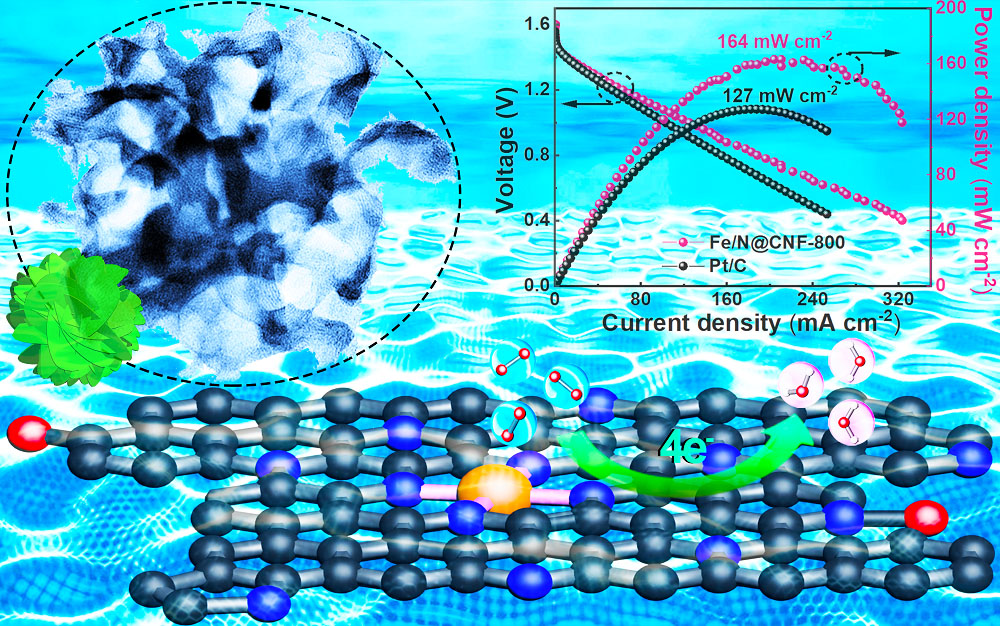The electrocatalytic ORR activities of Fe/N@CNFs were investigated and compared with the Pt/C catalysts in 0.1 mol·L
–1 KOH aqueous solution (Fig.4). Cyclic voltammetry (CV) was first employed to determine the ORR performance of the samples. As indicated in Fig.4(a), no typical peaks can be observed in N
2-saturated 0.1 mol·L
–1 KOH electrolyte for both Fe/N@CNF-800 and commercial Pt/C catalysts, whereas in O
2-saturated alkaline environment a distinct reduction peak can be observed. Notably, more positive oxygen reduction peak is exhibited by the Fe/N@CNF-800 compared to that of the Pt/C catalyst, certifying higher intrinsic ORR catalytic activity for Fe/N@CNF-800 [
41]. Furthermore, corresponding linear sweep voltammetry (LSV) measurements were also carried out under O
2-saturated 0.1 mol·L
–1 KOH condition (Fig.4(b)). The onset potential (
Eonset) and half-wave potential (
E1/2) of Fe/N@CNF-800 were 1.02 and 0.89 V vs. RHE (reversible hydrogen electrode), respectively, which are more positive than the respective values of Fe/N@CNF-700 (0.95 and 0.82 V), Fe/N@CNF-900 (0.98 and 0.87 V) and commercial Pt/C catalyst (1.01 and 0.86 V). This result reflects the critical role played by the calcination temperature during the synthesis of catalyst. Optimal balance between Fe–N
x, graphitic-N and pyridinic-N active sites can be obtained via appropriate choice of pyrolysis temperature which will subsequently improve the ORR performance greatly. Furthermore, the ORR activity of Fe/N@CNF-800 also was found to exceed most of the recent metal-based carbon electrocatalysts (Table S2, cf. ESM). Moreover, the limiting current density of Fe/N@CNF-800 is also superior to that of commercial Pt/C under identical conditions owing to the high-density active centers and fast mass/electron/ions transport of Fe/N@CNF-800 [
42]. The LSV curves of Fe/N@CNF-800 were also measured at varying sweeping rates to gain insights into the dynamics of ORR (Fig.4(c)). Increasing sweeping rate results in increasing diffusion current thanks to the shorter diffusion distance. The inset of Fig.4(c) presents the linear Koutecky–Levich (K–L) curves at various potentials. Based on the corresponding K–L equations, the average electron transfer number (
n) was calculated to be 3.97–4.00 (Fig.4(d)), demonstrating an admirable 4e
– reduction pathway on Fe/N@CNF-800 [
43]. These obtained results demonstrate the significant progress made in the study of high-efficiency transition metal/carbon-based catalyst for replacing precious metal electrocatalysts. N
2 sorption slope can be employed to evaluate the kinetics process of the ORR. The Fe/N@CNF-800 displays smaller Tafel slope (58 mV·dec
–1) than that of commercial Pt/C catalyst (83 mV·dec
–1), verifying the faster ORR dynamic process of Fe/N@CNF-800 catalyst (Fig. S13, cf. ESM) [
7]. Furthermore, rotation ring disk electrode was conducted to monitor the generation of H
2O
2 and calculate electron-transfer number value during ORR process. The H
2O
2 yield of Fe/N@CNF-800 was below 5% in the 0.2–0.8 V potential range. Additionally, Fe/N@CNF-800 also possessed the highest electron-transfer number (3.84–3.99), higher than that of commercial Pt/C catalyst (Fig. S14, cf. ESM). The corresponding
i–t curves were also used to study the methanol resistance of Fe/N@CNF-800 and commercial Pt/C catalyst in 0.1 mol·L
–1 KOH electrolyte. Impressively, the current density of Fe/N@CNF-800 hardly change after adding 1 mol·L
–1 methanol into the testing electrolyte at 200 s, whereas a sharp decline emerges for Pt/C catalyst (Fig. S15, cf. ESM). These results assert the great methanol resistance of Fe/N@CNF-800, which provides a great platform for the synthesis of ORR catalysts with high methanol tolerance. Stability is another key parameter for the ORR catalyst in practical applications. The stability of Fe/N@CNF-800 was tested by LSV technique in O
2-saturated 0.1 mol·L
–1 KOH electrolyte [
44]. As presented in Fig.4(e), the current density of Fe/N@CNF-800 maintains ~92% after 100000 s continuous test, outperforming the ~82% of commercial Pt/C catalyst under the same test condition. The Fe/N@CNF-800 of
E1/2 only shows slight negative shift (~12 mV) after 10000 CV cycles measurements, further demonstrating the super stability of Fe/N@CNF-800 catalyst (Fig.4(f)).









